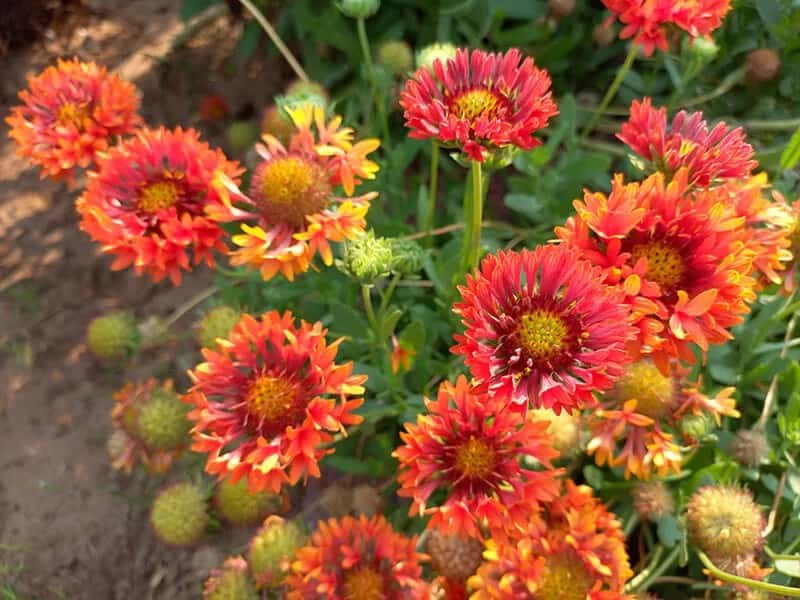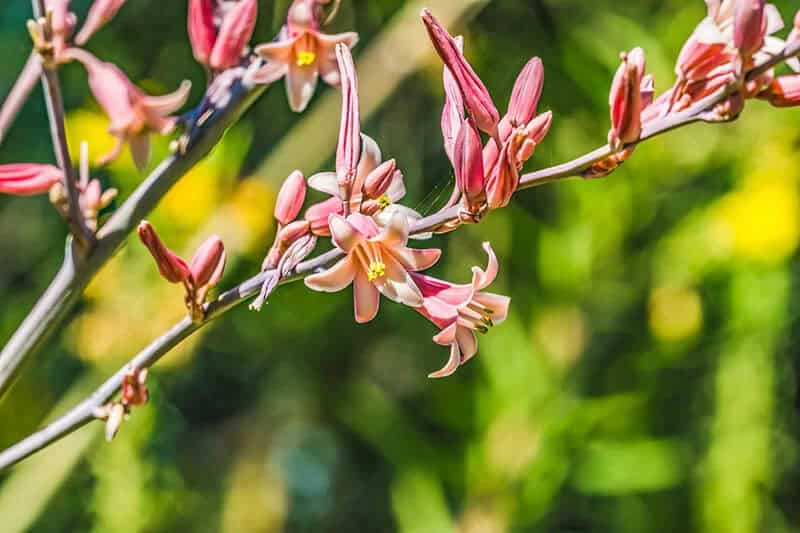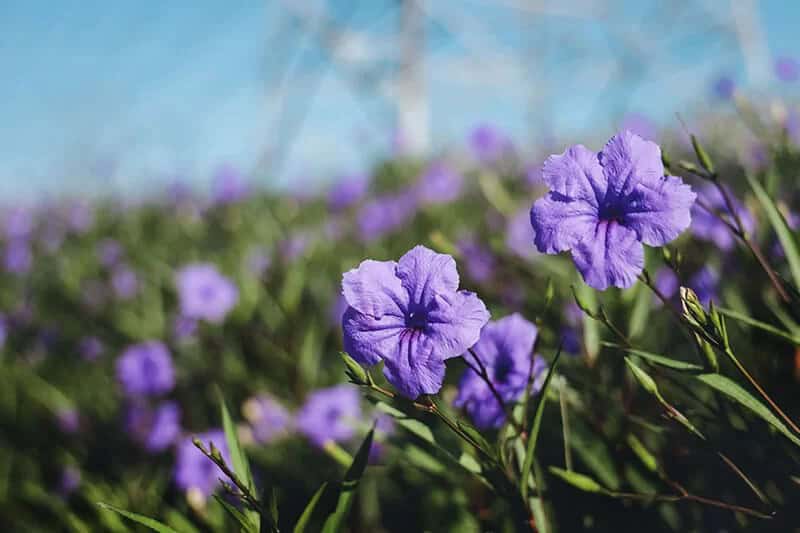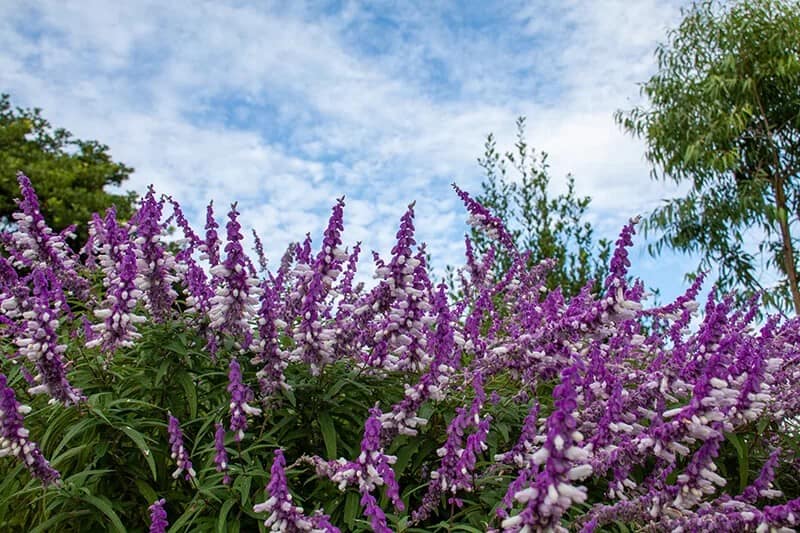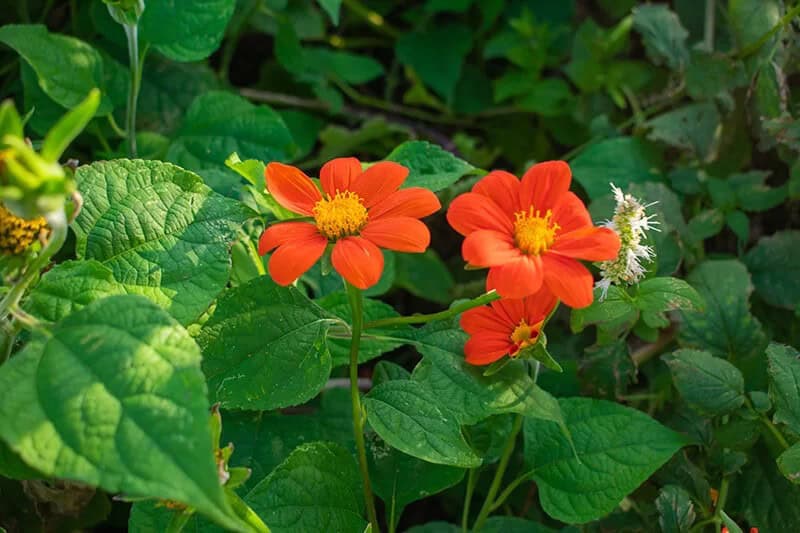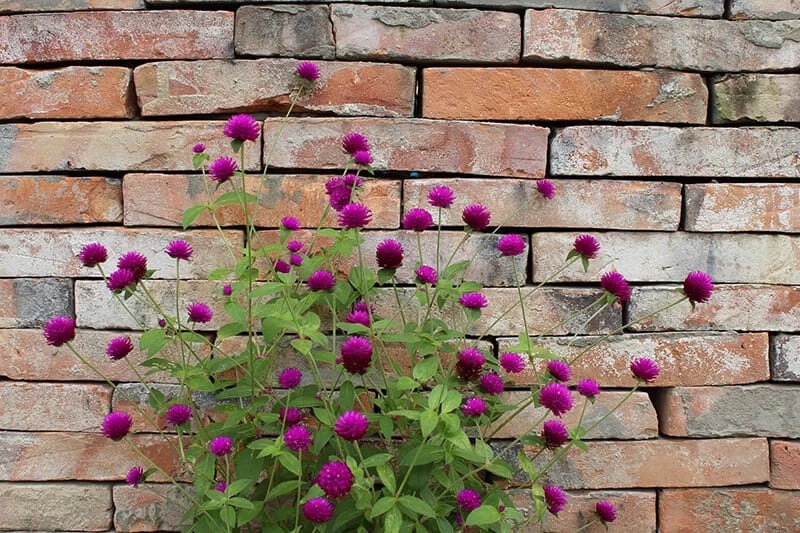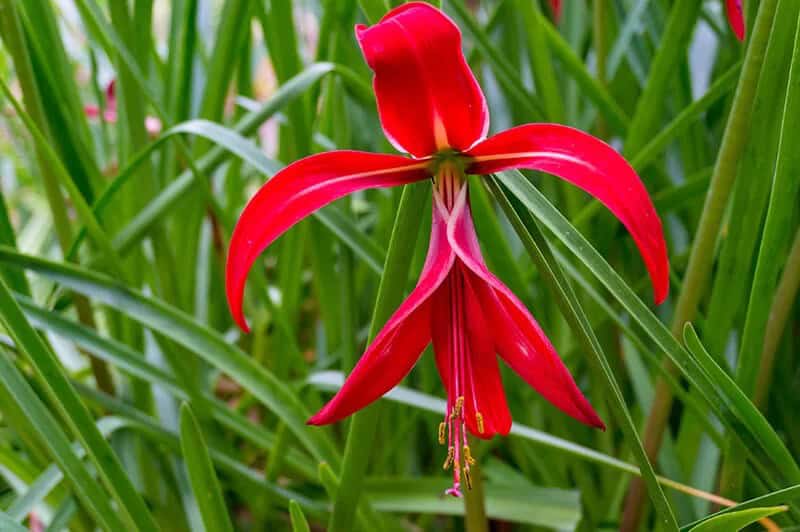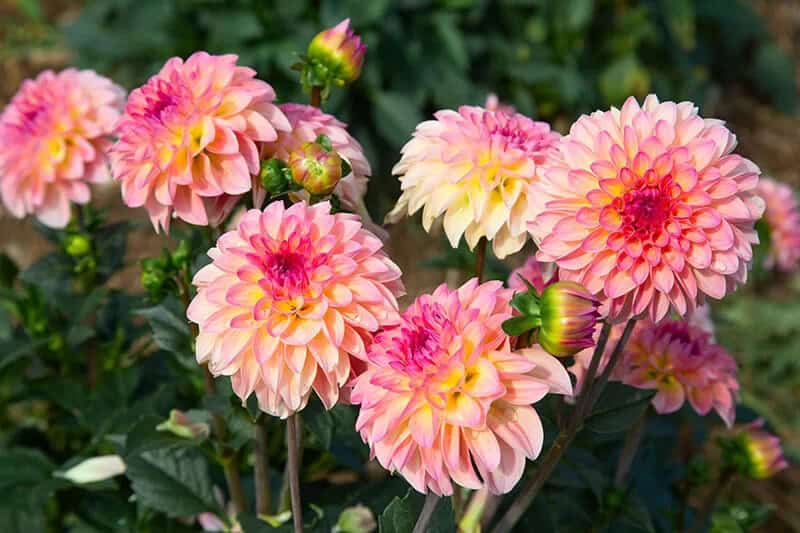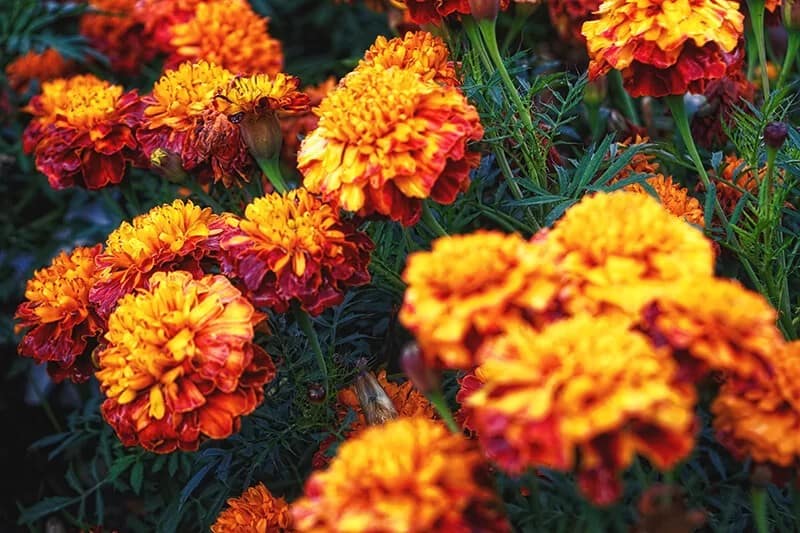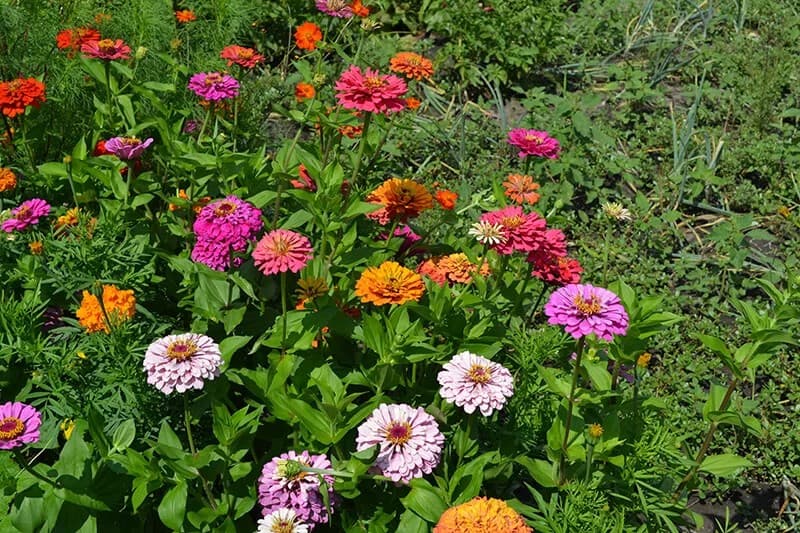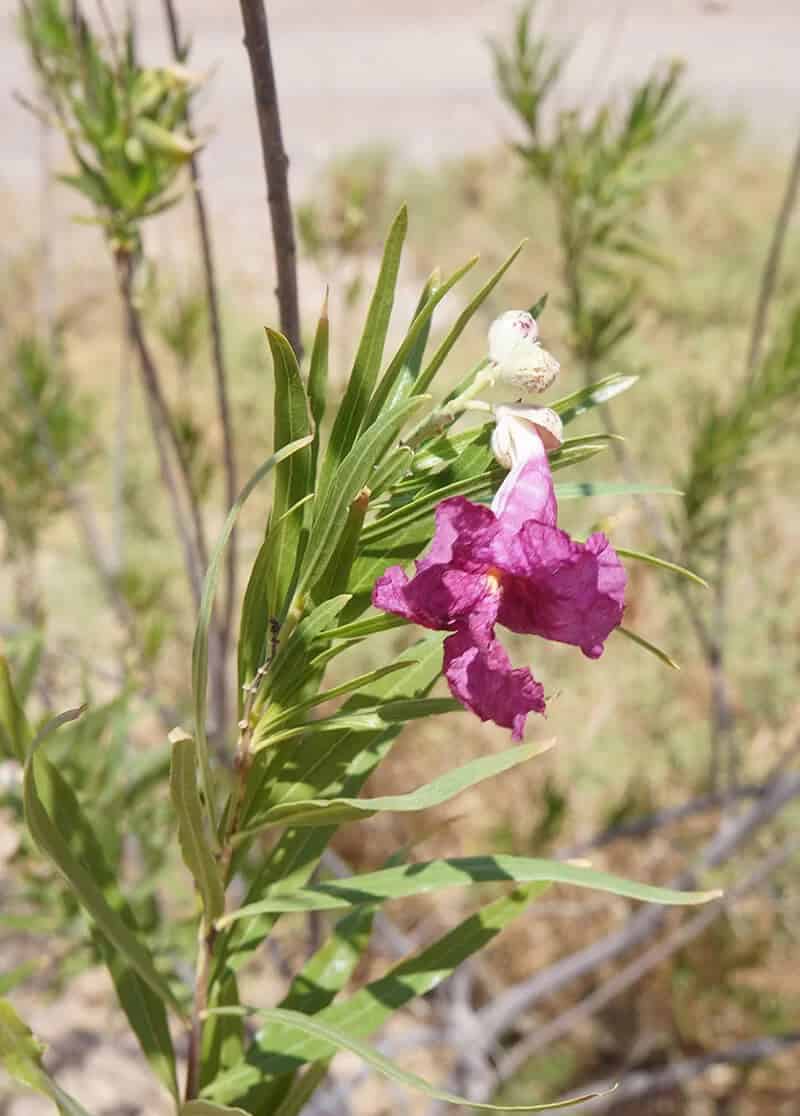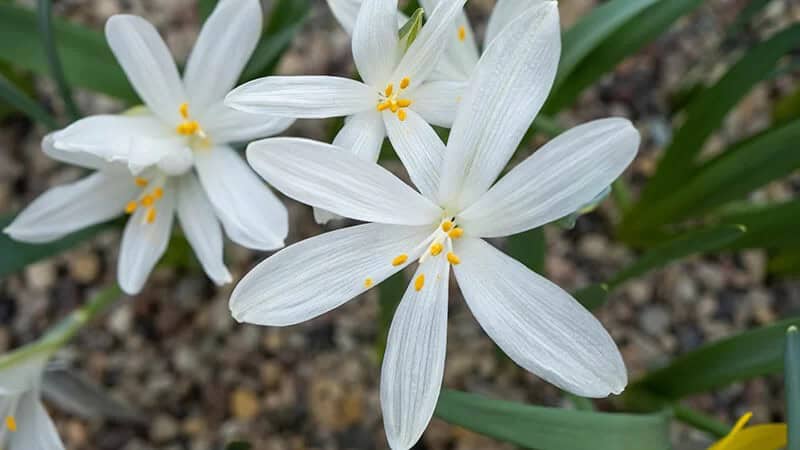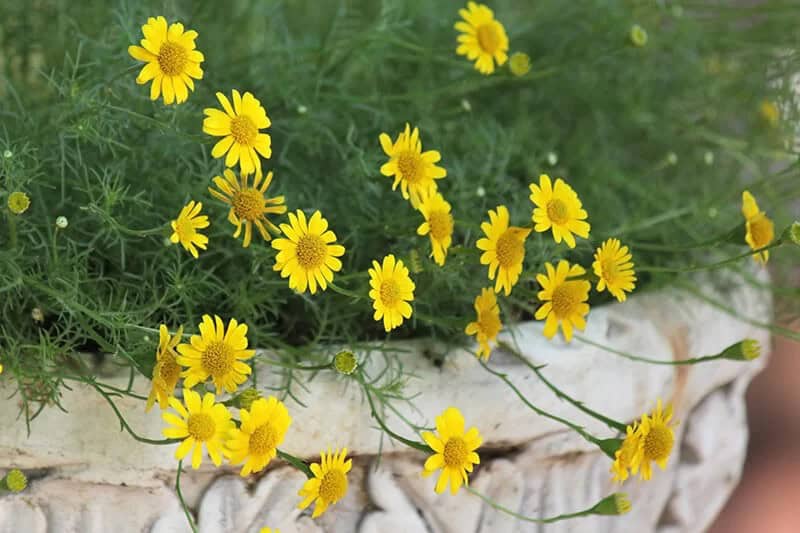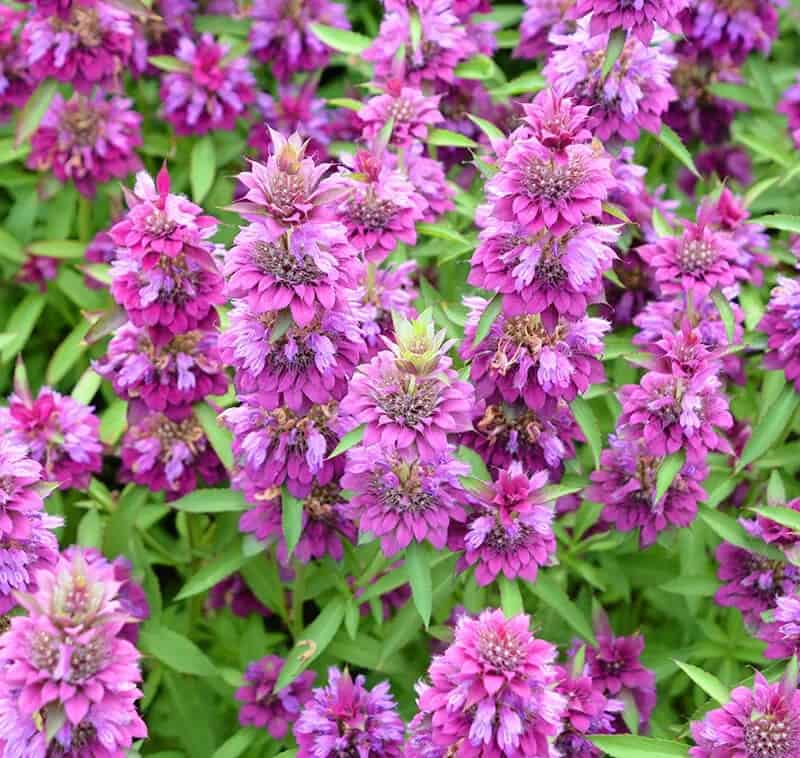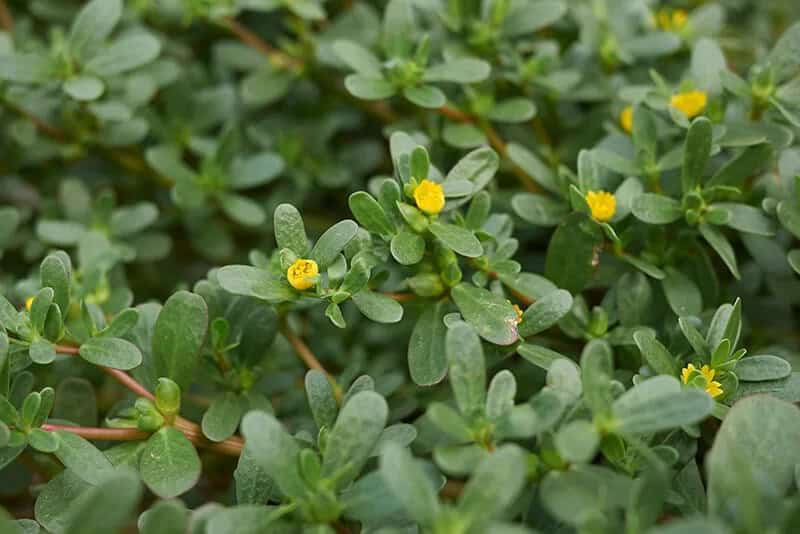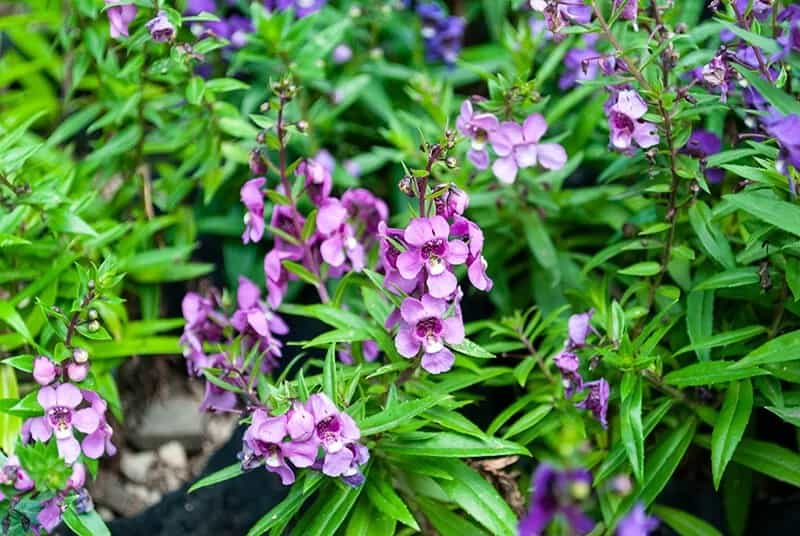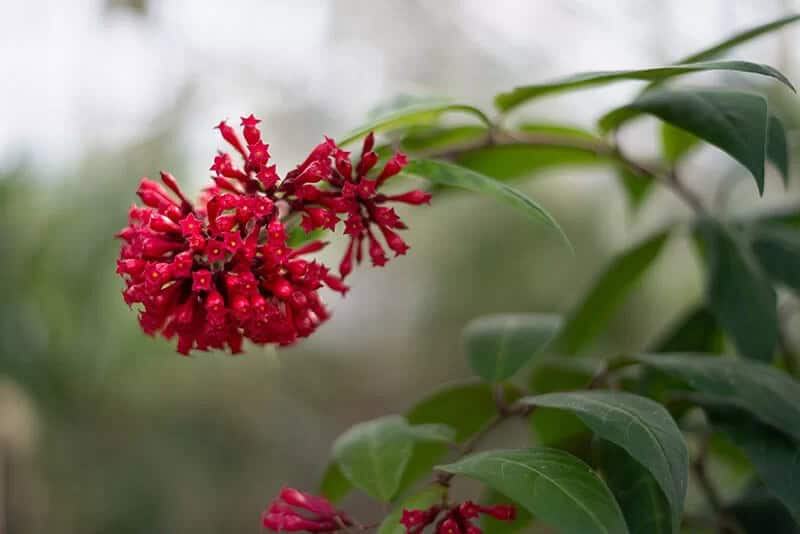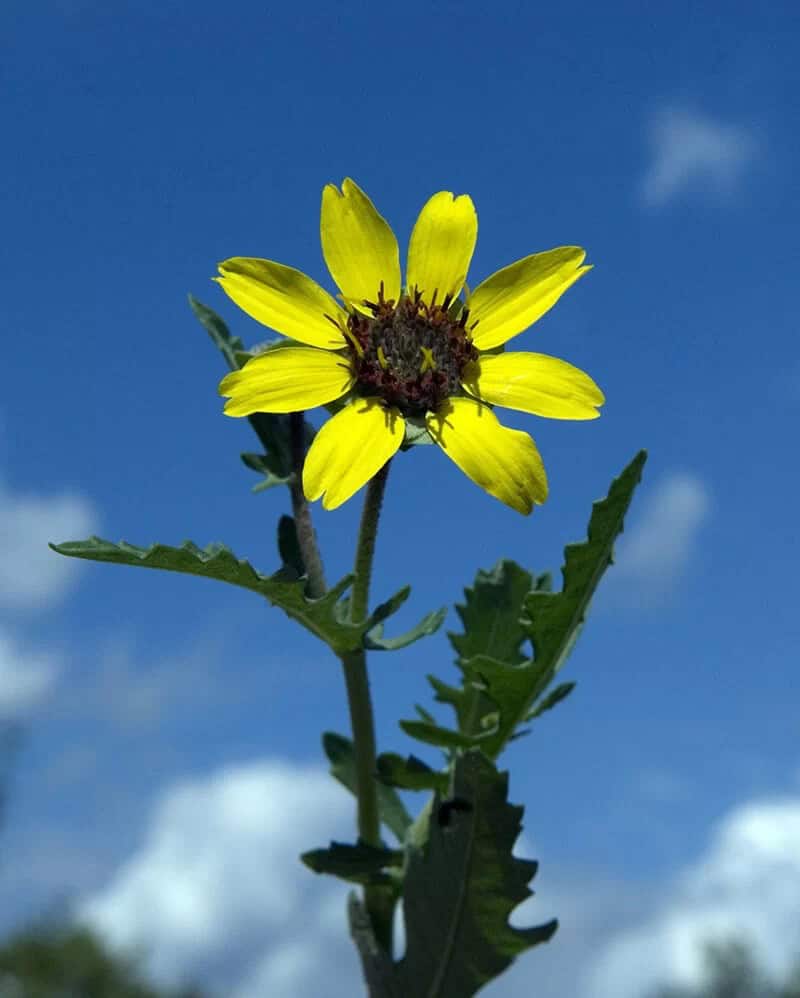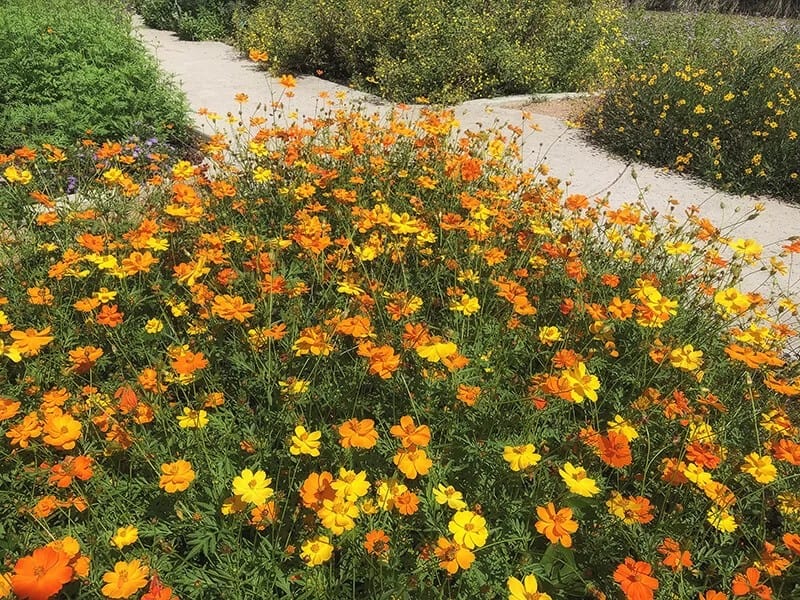Immersive beauty abounds in the vibrant realm of Mexican flowers, where extravagant blooms mingle with humble ones. This enchanting world is rooted in ancient traditions, weaving together mystique, grandeur, and a pinch of magic. As you step into this horticultural heritage, steeped in history and wonder, get ready to be transported to a landscape teeming with life and color.
27 of the Most Playful Mexican Flowers to Plant for a Garden Filled with Color
While browsing through the selection of flowers below, you may find familiar faces such as the poinsettia and marigold. However, you’ll also discover some unexpected gems like the chocolate flower that are sure to capture your attention. By incorporating these varieties into your garden, you can experience the vibrant beauty of Mexican flowers without leaving your own backyard.
Mexican Orange Blossom (Choisya Ternata)
Native to vast areas of the southwestern United States and Mexico, this evergreen shrub emits a captivating fragrance. The leaves and vibrant orange flowers share a sweet aroma reminiscent of orange blossoms, making it an ideal choice for creating a fragrant hedge along pathways or seating areas. Its prolonged blooming season from May to September only adds to its appeal as a desirable addition to any landscape design.
Prickly Pear (Opuntia Macrorhiza)
Despite challenging growing conditions, the prickly pear cactus can still thrive in your garden. This hardy plant symbolizes humor, hope, and endurance, making it a great addition to any outdoor space. To cultivate this beauty, you’ll need dry soil with good drainage, which makes it an ideal choice for sandy soils. The prickly pear’s growth is not limited by geographic region, as it can be grown in USDA zones 3 through 9.
It also requires full sun to produce its stunning display of pale yellow flowers from June to July, providing a lovely contrast to the spiky green foliage.
Firewheel (Gaillardia Pulchella)
Firewheel flowers, characterized by their vibrant colors and robust resilience, create a stunning display of color wherever they are cultivated. These Mexican wildflowers thrive in a range of conditions, tolerating dry to medium soil moisture levels and average soils with good drainage. While they can tolerate poor soils, optimal growth is achieved when provided with well-draining soil. Firewheel flowers also exhibit impressive hardiness, thriving in growing zones 2 to 11.
As a symbol of new motherhood, these blooms evoke feelings of serenity. In terms of light requirements, firewheels demand full sun exposure to flourish. One of the most notable features of Firewheel is its extended blooming period, which commences in June and continues until frost. When allowed to seed, these flowers will attract goldfinches if not immediately deadheaded after flowering.
Hummingbird Yucca (Hesperaloe Parviflora)
Incorporating a touch of tropical flair into your xeriscaping endeavor? The hummingbird yucca (Eureka Yucca) might just be the perfect addition. This striking plant is renowned for its ability to flourish in arid, desert-like environments, where sandy soils and full sun are the norm. Its long-blooming tubular pink flowers not only bring a pop of color to the barren landscape but also attract hummingbirds, adding an extra layer of beauty to your desert surroundings.
With its low-maintenance requirements – it can survive in dry conditions with minimal watering needs – this plant is perfect for gardeners looking to create a thriving oasis in even the most inhospitable environments.
Upright Prairie Coneflower (Ratibida Columnifera)
The humble prairie wildflower is an inviting addition to any garden, offering a playful and vibrant display of colour throughout the summer months. Its unique two-inch-long cones add an intriguing element to its beauty, while the bright yellow petals bring a splash of joy to the overall effect. Notably, the flower’s shape bears a striking resemblance to a slender sombrero, adding a touch of whimsy to its charm.
In terms of growing conditions, this bushy perennial prefers dry to medium soil moisture and average soils with good drainage, although it can tolerate poor soils as well. It thrives in full sun and is suitable for USDA growing zones 4-9, making it an ideal choice for many gardeners.
Mexican Petunia (Ruellia Simplex)
This vibrant petunia thrives with perpetual hopefulness, as symbolized by the 🔮 icon. Its water requirements are moderate to wet, allowing for some drought tolerance. The 🪴 soil must be rich in humus and possess good drainage, though it can adapt to boggy conditions if needed. Growing zones 8 to 10 provide an ideal environment for this annual to flourish. It basks in the ☀️ warmth of full sun to part shade, with a prolific blooming season that rewards continuous flowering.
Although typically a summertime annual, this petunia will adapt to various growing conditions, persisting until winter’s chill sets in. However, if your winters remain warm, be cautious as it can become invasive.
Mexican Bush Sage (Salvia Leucantha)
The majestic Mexican bush sage is a stunning addition to any garden, boasting a plethora of symbolism and characteristics that make it a sought-after flower. 🌸 With its long history of longevity, wisdom, esteem, and good health, this annual beauty grows into a 36-inch tall bush adorned with elegant bicolor flowers in shades of purple and white.
🔮 As an annual in cooler climates, Mexican bush sage thrives under the right conditions, requiring medium water needs, fertile soils with good drainage, and full sun ☀️ to reach its full potential. 🌍 Its growing zones range from 8 to 10, making it perfect for those living in areas with similar climates. The best part? This gorgeous flower blooms from August until the first frost, providing a stunning display of color and beauty for your garden.
🌱 And if you’re lucky, you might even catch a glimpse of hummingbirds sipping nectar from these beloved flowers!
Goldflower of the Incas (Tithonia Rotundifolia)
Globe Amaranth (Gomphrena Globosa)
The Mexican flower, a symbol of tender affection and immortality, has an air of mystique surrounding it. Its true form is humble, with small white petals that often go unnoticed. The real showstopper, however, are the vibrant magenta bracts that unfurl like paper-like spheres throughout the summer. These remarkable globes retain their intense color for months after being cut, making them a prized addition to any cut-flower garden or floral arrangement.
When it comes to growing conditions, this flower thrives in medium water needs and average soil with good drainage, tolerating temperatures between zones 2 to 11. It requires full sun to reach its full potential, and blooms from June until the first frost.
Aztec Lily (Sprekelia Formosissima)
The captivating Aztec lily boasts a distinctive shape and vibrant color, making it an unforgettable Mexican bloom. This alpine flower thrives in rocky and sandy soil with good drainage, which is vastly different from the typical loamy conditions. While it’s native to southern Mexico, the Aztec lily can still be cultivated as a stunning container-bound houseplant for those living outside its natural habitat.
Its medium watering needs, full sun exposure, and blooming season of March to April also make it an attractive option for plant enthusiasts.
Dahlia (Dahlia)
Dahlias stand out with their big and bold blooms, requiring a bit more TLC than other flowers to thrive. Native to Mexico, these show-stopping flowers demand medium watering, fertile soil with good drainage, and full sun to shine in zones 7-10. In return for your effort, you’ll be rewarded with stunning displays that are perfect for grouping at least five together.
As a bonus, dahlias are highly sought after as cut flowers, making them a great choice for gardeners looking to get creative with their arrangements.
French Marigold (Tagetes Patula)
French marigold, despite its name, has its roots in Mexico rather than France. This low-maintenance bloom is an ideal choice for novice gardeners due to its ease of cultivation. The flower’s versatility is further highlighted by its diverse range of forms and colors, boasting vibrant shades of yellow, orange, and burgundy.
Symbolically, French marigold represents respect, creativity, grief, and jealousy, while requiring medium water levels, average soil with good drainage, tolerance for clay soil, and full sun exposure. Its growing zones span from 2 to 11, with a blooming season that stretches from June until the first frost.
Creeping Zinnia (Zinnia Angustifolia)
The symbolism behind creeping zinnia is deeply rooted in friendship, endurance, and lasting affection, making it a thoughtful addition to any garden design. These vibrant blooms thrive in well-draining fertile soils and full sun, with a tolerance for dry conditions. With a growing range of 2 to 11, they’re adaptable to various climates. As the name suggests, creeping zinnia’s compact growth habit makes them ideal for edging gardens or adding a pop of color along pathways. The best part?
They bloom from June until frost, providing months of beauty with minimal maintenance. No deadheading required! Whether you’re looking for a statement piece or a low-fuss addition to your outdoor space, creeping zinnia’s playful colors and hardy nature make them an excellent choice.
Peace Lily (Spathiphyllum)
The peace lily’s symbolism is deeply rooted in its tranquil and calming nature, representing attributes such as innocence, purity, healing, hope, and prosperity. This beautiful plant requires medium watering needs, tolerates average soil conditions, and can thrive in a wide range of growing zones from 11 to 12. When it comes to light exposure, peace lilies prefer partial shade to full shade, allowing them to flourish without intense sun exposure.
One of the most striking features is its blooming season, where flowers bloom freely, adding an air of serenity to any garden or indoor space. Interestingly, this popular container plant has a surprise origin in Mexico, where large, glossy leaves and white inflorescence evoke feelings of peacefulness and harmony.
Desert Willow (Chilopsis Linearis Lucretia Hamilton)
The desert willow, with its vibrant fuchsia flowers, is an attractive addition to any garden. Its ability to thrive in dry to medium conditions, tolerating drought, makes it an ideal choice for areas with limited watering options. While it can tolerate rocky soil and slightly alkaline conditions, good drainage is essential for healthy growth. This shrub’s hardiness allows it to flourish in growing zones 6 through 9.
With full sun exposure, the desert willow produces clusters of blooms from May to June, attracting hummingbirds and butterflies to your garden. Its compact size, with a spread of around 20 feet, requires thoughtful planning to incorporate into your landscape design. This variety is particularly notable for its deeply colored flowers, which add a pop of color to any outdoor space.
Morning Glory (Ipomoea Purpurea)
Morning glories are renowned for their striking white-throated blooms and impressive growth rate. Despite their allure, however, they can be quite aggressive in their spread. This hasn’t deterred gardeners through the ages, including the ancient Mayans who cultivated these vining flowers for their beauty. To bring joy to your outdoor space, consider providing a basket or trellis for your morning glory vine to wrap itself around, showcasing its elegant flowers from June to October.
Morning glories thrive in well-drained soil with moderate moisture levels and can tolerate full sun, making them suitable for gardeners in USDA hardiness zones 2-11.
Zephyr Lily (Zephyranthes ‘Itsy Bitsy’)
The zephyr lily is steeped in symbolism, representing anticipation, rebirth, and new beginnings, as well as big expectations. When it comes to growing this stunning flower, you’ll need to provide a medium amount of water. The soil should be fertile with good drainage, allowing the roots to breathe. As for climate, zephyr lilies thrive in zones 7-10, where they can soak up full sun to partial shade.
During the blooming season, which typically falls between August and September, these ancient lilies will burst forth with vibrant yellow and white petals. In Mexico, rain showers trigger this explosion of color, adding a touch of elegance to any space. Whether grown individually or in groups, zephyr lilies are an excellent choice for rock gardens, bringing a pop of beauty and symbolism to the forefront.
Sunflower (Helianthus Annuus)
Sunflowers stand tall as giants among annual flowers, with some varieties reaching up to 15 feet in height. While the vibrant yellow petals in this photo are striking, it’s worth noting that these majestic blooms can be found in a variety of colors, from deep burgundy to soft pastels. Due to their stature and energetic presence, sunflowers are often used as borders, adding a dramatic touch to any garden or landscape.
In terms of growing conditions, sunflowers thrive in dry to medium soil with good drainage, tolerating poor soil if necessary. They require full sun and can be grown in zones 2 to 11. Blooming season typically occurs from July to August, making them a popular choice for summer gardens.
Shooting Star (Thymophylla Tenuiloba)
For those seeking to add a pop of color and whimsy to a rock garden or desert landscape, yellow shooting star flowers (Dichelostemma congestum) are an excellent choice. These long-blooming flowers thrive in dry to medium soil conditions with good drainage, making them perfect for areas that receive full sun (6+ hours of direct sunlight). With a growing zone range of 9-10, they’re well-suited for gardens in warmer climates.
The ideal blooming season for yellow shooting star flowers is June until frost, providing a vibrant display of color throughout the summer months.
When incorporating these charming flowers into your landscape design, consider pairing them with more show-stopping blooms to create visual interest and depth. By doing so, you’ll be able to cultivate a captivating ambiance that’s perfect for relaxing or entertaining.
Lemon Mint (Monarda Citriodora)
Lemon mint’s versatility is one of its greatest charms. Its ability to thrive in a wide range of conditions, from dry to medium soils and full sun to part shade, makes it an ideal choice for bringing life to neglected spaces. In fact, its hardy nature allows it to grow effortlessly wherever it’s planted. The result is a landscape transformed into a haven for pollinators like butterflies, hummingbirds, and honeybees.
As the purple flowers bloom from May to August, the air is filled with the sweet scent of lemon, released when the leaves are gently rubbed. Whether planted in sweeping curves or scattered throughout your garden, lemon mint’s allure is undeniable.
Moss Rose (Portulaca Oleracea)
Among the many types of Mexican flowers cherished by the ancient Mayans, moss rose stands out with its striking foliage and pops of color. Its remarkable ability to flourish in rocky soil where others might struggle makes it a symbol of resilience. When planted alongside paths as an edging element, these vibrant blooms add a charming touch. Moss rose requires dry to medium watering, average soil with good drainage, and full sun exposure.
It thrives in USDA hardiness zones 2-11, blooming from June until frost.
Angel’s Trumpet (Datura Inoxia)
Angel’s Trumpet, a perennially intriguing plant, harbors profound symbolism within its delicate white blooms. These flowers are not only a spiritual beacon, but also convey a sense of power and caution. In terms of cultivation requirements, Angel’s Trumpet demands medium water needs and thrives in rich soils with good drainage. This enchanting shrub is best suited for temperate climates where it can be grown as an annual, sprawling across the landscape.
During July until the onset of frost, this plant explodes into bloom, releasing a potent fragrance that captivates all who behold it. A member of the nightshade family, Angel’s Trumpet may appear heavenly, but it is crucial to note its toxicity – a testament to the complexity and intrigue surrounding this captivating plant.
Summer Snapdragon (Angelonia Angustifolia)
Summer Snapdragon, native to Mexico, is a vibrant addition to any landscape. This striking flower produces spikes of snapdragon-like blooms that are sure to grab attention. For those living in cooler temperate climates, Summer Snapdragons can be treated as annuals. While the blue-violet hue may not appeal to everyone, this beauty can also be found in white, pink, and multi-colored varieties for added versatility.
In terms of its growing requirements, Summer Snapdragon prefers well-drained fertile soil and full sun to thrive. It’s a moderate water user that can tolerate some drought, but will perform best with medium watering needs. Its ideal growing zones are 9-11, making it suitable for those in warmer climates. When it comes to blooming season, Summer Snapdragons put on a show from June to September, adding a pop of color to any garden or outdoor space.
Purple Cestrum (Cestrum Elegans)
The majestic purple cestrum is an irresistible haven for hummingbirds, its striking red-violet tubular flowers resembling a sweet treat for these tiny creatures. Native to southern Mexico, this versatile shrub has the unique ability to climb and thrive in average soils with good drainage. With pruning being a therapeutic activity for many garden enthusiasts, the purple cestrum’s adaptability to full sun to part shade conditions makes it an ideal addition to any landscape.
When incorporated into a bird-friendly garden, this flowering beauty can provide hours of entertainment as hummingbirds flit from bloom to bloom throughout the summer months.
Yellow Jessamine (Gelsemium Sempervirens)
Yellow Jessamine is a stunning addition to any landscape, bringing joy and vibrancy with its bright yellow blooms. Its versatility as both a groundcover and climber makes it an ideal choice for creative landscaping. With medium water requirements, rich soil with good drainage, and full sun, this Mexican native thrives in zones 7-10. From February to April, it bursts forth into bloom, illuminating the winter-weary landscape with its radiant colors.
Chocolate Flower (Berlandiera Lyrata)
The captivating charm of the chocolate flower lies not just in its rich, velvety petals but also in the intoxicating aroma it releases, reminiscent of fine chocolates. This delightful bloom is a sensual experience, evoking feelings of intense love and indulgence. As you meander through your garden on a sunny morning, the scent of chocolate wafts through the air, beckoning you to stop and savor the moment.
With its adaptable nature, the chocolate flower thrives in dry to medium soil conditions, preferring average soils with good drainage and a slightly alkaline pH. This hardy bloom is suitable for zones 4 to 10 and flourishes in full sun. Its blooming season spans from May to October, making it a delightful addition to any garden.
The beauty of the chocolate flower lies not just in its appearance but also in the sensory experience it provides, inviting you to indulge your senses and connect with nature.
Orange Cosmos (Cosmos Sulphureus)
The orange cosmos, with its symbolism tied to ambition, order, and harmony, is an ideal addition to any garden. This flowering annual thrives in dry to medium conditions, making it perfect for areas with average soils that drain well – it can even tolerate poor soil if needed. Orange cosmos can be grown in USDA zones 2 through 11, giving you a wide range of options depending on your location.
As the sun shines bright (full sun is required), these bushy annuals burst into bloom from June to September, offering long-lasting color and beauty. A unique characteristic of this flower is that it actually does better in less-fertile soil conditions, so don’t be afraid to give it a spot with some poor soil if you have it available. For a more dramatic display, look for double-flowering cultivars to add an extra touch of glamour to your landscape.
27 of the Most Playful Mexican Flowers to Plant for a Garden Filled with Color
Despite Mexico’s generally warmer climate compared to the majority of the United States, it may surprise you that many Mexican flower varieties can actually tolerate cooler temperatures without issue. In fact, by treating less hardy types as annuals or houseplants, you can still enjoy their vibrant beauty even in colder conditions. When designing your garden, keep these resilient and low-maintenance flowers in mind, particularly those that struggle to thrive in certain areas.
Their ability to flourish in challenging environments makes them an excellent choice for filling gaps and adding a pop of color to your outdoor space.


